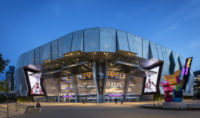A vibrant concert hall, a wind farm perched high above a Hawaii town and a sustainable winery education facility: This year's ENR California top projects certainly are a diverse group.
But all of the projects that impressed the panel of judges also share certain traits. Collaboration was deeply ingrained among the teams, with owners, design firms and contractors taking advantage of new technology and old-fashioned know-how to design and build more efficiently. Many teams also espoused a deep commitment to sustainability, with three winning projects targeting net-zero energy use and more aiming for LEED certification.
For many judges, however, the paramount factor was a project's benefit to its community. The winning projects—from a water recycling facility that educates politicians and citizens about improved treatment strategies to seismic retrofits for a university stadium—fulfill essential needs in their localities.
The winners were culled from 104 projects submitted to ENR California by means of an online entry system. A panel of 11 judges was assembled from all walks of the industry, including architects, engineers, subcontractors and general contractors. Judges were divided into three groups to tackle select categories and were matched, whenever possible, to their areas of expertise.
The judges reviewed and scored each entry on several criteria: overcoming challenges, teamwork, safety, innovation, contribution to the community, construction quality/craftsmanship and the function and/or aesthetic quality of the design. Entries for projects that had a construction-related death were not accepted.
If a judge worked for a firm directly involved in a submitted project, he or she was assigned to a different category and did not participate in the scoring or discussion of any competing projects.
The judges then met to debate and discuss the merits of the high-scoring finalists and determine the winners in 20 main categories, ranging from airports/transit to water/environment. Judges could select a Northern California and a Southern California winner in some of the larger categories.
A separate panel of safety specialists reviewed entries for ENR California's Excellence in Safety award. More than 50 projects were considered and judged based on their Occupational Safety and Health Administration incident rates, lost-time accidents, total worker-hours and the quality of the team's safety program.
The judging culminated in the selection of three nominees for Project of the Year, taken from the category winners. They are: the Bing Concert Hall, Conrad N. Hilton Foundation Headquarters and I-210 Gold Line Bridge. One was chosen Northern California Project of the Year (see p. 10); another was named Southern California Project of the Year (see p. 13).
ENR California will honor all of the winners at two awards banquets, one in San Francisco on Dec. 3, the other in Long Beach on Dec. 5. Winners in each category will advance to compete against top projects from nine other U.S. regions in ENR's Best of the Best Projects competition.
ENR California Best Projects Panelists
Barbara Eljenholm, senior vice president, RBF Consulting, a company of Michael Baker International
Craig Halverson, senior vice president, ARCADIS U.S. Inc.
Paul D. Little, CEO, Panattoni Construction Inc.
Erin McConahey, principal, Arup
Mark Roddy, design principal, SmithGroupJJR
Adam Spillane, division manager – San Francisco, Cupertino Electric Inc.
Marcus Staniford, vice president, operations, Rudolph and Sletten Inc.
Ryan T. Stichler, business development manager, Kitchell
Jeff Turner, vice president/district manager, Flatiron Construction Corp.
Joseph Yao, Sr., project manager, DPR Construction
Mehrdad Yazdani, design principal, Yazdani Studio of Cannon Design
ENR California Excellence in Safety Award Panelists
Gena Roberts, regional senior safety manager, Swinerton Builders
Michael Suedkamp, regional safety manager, Gilbane Building Co.

























